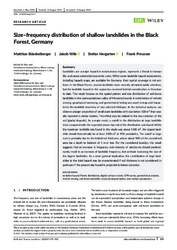Size–frequency distribution of shallow landslides in the Black Forest, Germany
DOI: https://doi.org/10.1002/esp.5237
Persistent URL: http://resolver.sub.uni-goettingen.de/purl?gldocs-11858/9863
Persistent URL: http://resolver.sub.uni-goettingen.de/purl?gldocs-11858/9863
Büschelberger, Matthias; Wilk, Jakob; Hergarten, Stefan; Preusser, Frank, 2021: Size–frequency distribution of shallow landslides in the Black Forest, Germany. In: Earth Surface Processes and Landforms, Band 47, 1: 179 - 192, DOI: 10.1002/esp.5237.
 |
Dokument öffnen: |
Landslides are a major hazard in mountainous regions, represent a threat to human life, and cause substantial economic costs. While some landslide hazard assessments, including hazards maps, are available for Germany, their spatial coverage is not uniform. In the Black Forest, several landslides have recently attracted public attention, but the landslide hazard in this region has received limited consideration in literature to date. This study focuses on the spatial pattern and size distribution of soil‐borne landslides in the submountainous valley of Menzenschwand. A combination of remote sensing, geophysical surveying, and geotechnical testing was used to map and characterize the landslide inventory of two selected hillslopes. In the statistical analyses, we observe a larger proportion of small‐scale landslides with size below 100 m2 than usually reported in similar studies. This effect may be related to the low cohesion of the soil (glacial deposits). As a major result, a cutoff in the distribution at large landslide sizes compared with the expected power‐law tail of the distribution was found. While the maximum landslide size found in this study was about 1100 m2, the largest landslide should theoretically be at least 2500 m2 at 95% probability. The cutoff at large sizes is probably due to the limited soil thickness, where about 50% of the considered area has a depth to bedrock of 1 m or less. For the considered location, this result suggests that an increase in frequency and intensity of rainstorms should predominantly result in an increase of landslide frequency, but without increasing the size of the largest landslides. As a more general implication, the contribution of large landslides to the total hazard may be overestimated if soil thickness is not considered, in particular if the present‐day hazard is projected to future scenarios. The spatial pattern and size distribution of soil‐borne landslides in low mountain ranges investigated using a combination of remote sensing, geophysical surveying, and geotechnical testing reveal a cutoff in the distribution at large landslide sizes and possible overestimation of future scenarios.
Statistik:
ZugriffsstatistikSammlung:
- Geologie [933]
Schlagworte:
landslide hazardPareto distribution
digital surface models
GPR survey
geotechnical analysis
remote sensing
soil‐borne landslides
drone photogrammetry
near‐surface geophysics
This is an open access article under the terms of the Creative Commons Attribution‐NonCommercial‐NoDerivs License, which permits use and distribution in any medium, provided the original work is properly cited, the use is non‐commercial and no modifications or adaptations are made.

